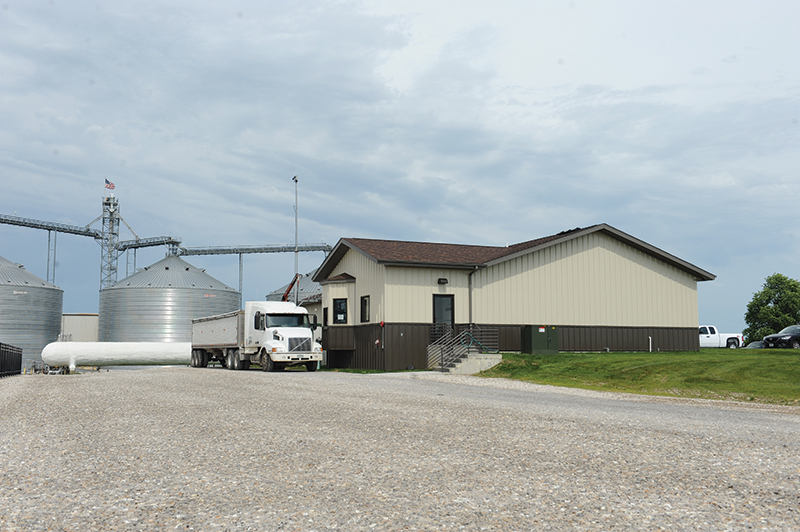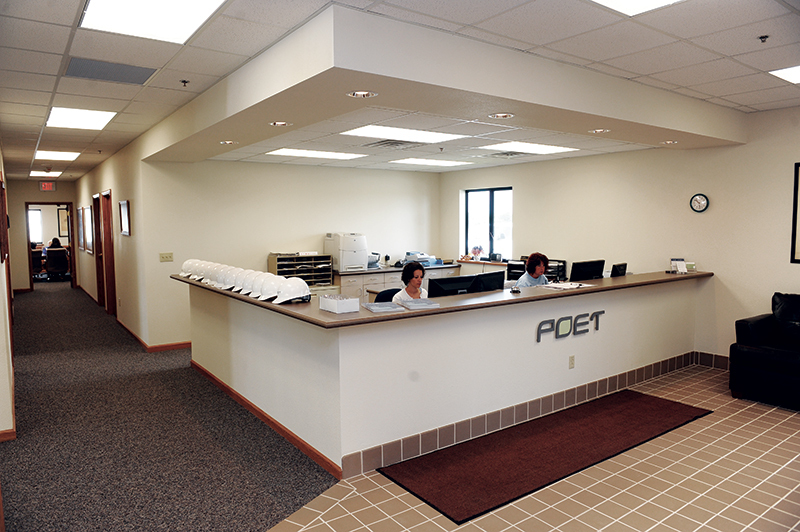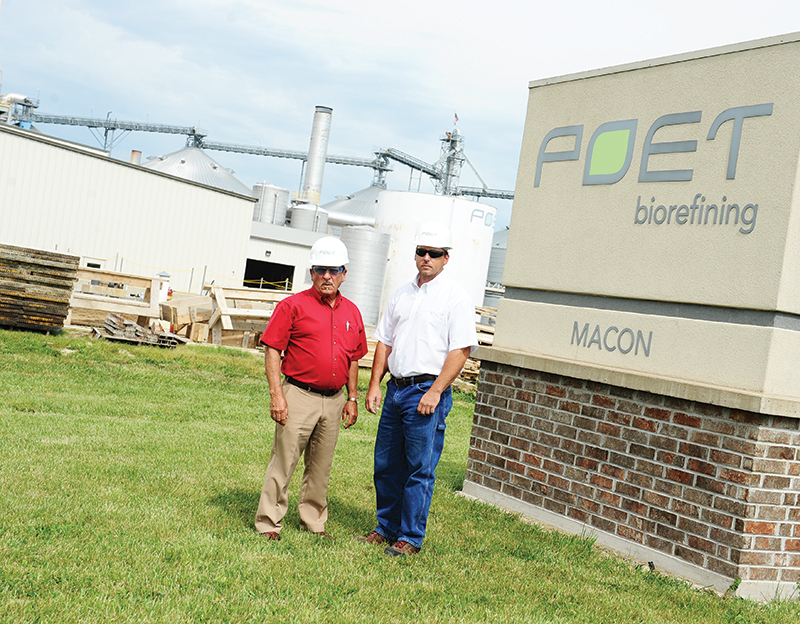Getting It Done




PHOTO: DAKOTA DYLAN
July 11, 2013
BY Susanne Retka Schill
Last summer’s drought was devastating in northeastern Missouri—worse than the Dust Bowl years, some old-timers tell Matt Gerhold, Poet Biorefining-Macon commodities manager. “Although the USDA put our area around 50 bushels to the acre, it was probably closer to 25 bushels on corn,” he says. “There’s a lot of acres that were abandoned.”
Not only was it a small corn crop, but the quality was poor, adds John Eggleston, board chairman.
What’s an ethanol producer to do when good corn just isn’t there? At the Poet plant in Macon, the board and staff consulted lists of small and major projects, gave Poet LLC’s design and engineering group in Sioux Falls, S.D., a call and said, “Let’s get ’er done.” In February, the plant shut down for 75 days as the contractors moved in and the plant staff tackled projects large and small.
“We had been planning these projects for some time,” Eggleston says. “And with the poor corn supply and tight margins, what better time to shut down?” The big projects already had been evaluated by the board, the engineering and cost estimates completed and board resolutions in place. “We also knew that for our existence in the future market and competitive environment, we had to make some changes. The weather kind of dictated it, because of lack of corn. It forced our hand, but what better time to do it? If you’re going to do major projects, it’s pretty hard to do with the plant running.”
Throughout the shutdown, the staff continued working regular shifts, tackling their own projects and helping contractors with theirs. “We got to do needed maintenance on the plant—things you can’t do easily with the plant running,” Gerhold says. “We all had our laundry lists made. We hit them one after the other. We had people working 24 hours a day during those 2.5 months we were down. And we still didn’t get everything done.”
Among the $14 million in upgrades were a new computer control system and new, more efficient evaporators. Corn oil extraction was added. A new administration building was built and the old removed, making room for additional fermentation tanks. The plant came back online in mid-April running at a reduced rate while construction of the additional fermenters for the conversion to BPX, Poet’s patented raw starch hydrolysis process, continues through the summer. “It’s designed to come up full bore with the onset of harvest,” Gerhold adds, “whenever that may be.”
Advertisement
The kingpin of upgrades is the conversion to the no-cook BPX process. Macon started operations in 2000, the year Poet began work on its Broin Project X technology, first installed at its Hudson, S.D., facility in 2004. Macon is the 25th of Poet’s 26 plants (not including the research center in Scotland, S.D.) to make the conversion.
It would be wrong to conclude that Macon has been slow to innovate. Early on, the board and management decided to capture the plant’s CO2 to supply the local and regional markets and Poet Ethanol Products was contracted to market the product. The ethanol plant also partnered with the city of Macon to install combined heat and power capability at the plant site. The city owns the turbine, which generates 10 megawatts of electricity sold to the grid, while the ethanol plant utilizes the waste steam for process heat.
Gerhold says he is often asked why it’s taken so long for Macon to tackle the major upgrade to the BPX process. As commodities manager, he explains one factor is the plant’s location and its impact on corn cost. Macon sits 60 miles east of Hannibal, Mo., on the Mississippi River and 60 miles south of the Iowa border. The rolling hills are home to a patchwork of pastures and relatively small fields, and farmers tend to favor soybeans over corn, 2 to 1. The ethanol plant sources corn from as far away as 100 miles to supply the 17 million bushels of corn needed annually. Macon was in operation when the ethanol industry went through its expansion years, Gerhold explains, “and because of our corn situation, there wasn’t a lot of competition that wanted to move into this area.” While the demand for corn increased in places like Iowa, Minnesota and South Dakota, it didn’t in Macon’s corn draw. “So our cost of corn, a lot of the time, was cheaper than it was up north.” A few years of poor yields in Missouri, topped by the devastating drought, changed that. “All of a sudden our corn prices are higher than everywhere else and, we were still running the old technology.”
Another factor was the plant had continually improved and was running efficiently and profitably. “When you’re running a production facility and you’re profitable, it’s pretty hard to slow your production levels,” Eggleston says.
This year’s projects certainly weren’t the plant’s first upgrade. “We started out at 15 MMgy, but that really wasn’t where we wanted to be,” he recalls. “Back in 2000, it was struggle to get financing. We built the initial plant with a lot of components in for expansion.” Within a week of startup, the plant exceeded its nameplate, achieving 23 MMgy by 2003 when the financing became available to expand to a 36 MMgy nameplate. “For several years after that we had very good runs,” he adds. “The plant profitability was there, we were ratcheting up production levels. In 2008, we finally achieved 45 MMgy rate of production.”
“Throughout the years, we’ve looked at ways we can increase production and also our efficiency levels to bring costs down,” Eggleston says. Macon had long been planning to install the full BPX process, doing some initial system upgrades earlier that brought its distillers grains quality up to Poet’s Dakota Gold premium standards. “Finally, with the drought, everything fit into the scheduling.”
Advertisement
Upgrading to the BPX process required an extended shutdown. “We made some changes in fermentation area, some changes to piping,” explains James Moe, president of Poet Design and Construction and Poet Plant Management. “Throughout the plant, there’s quite a few mechanical modifications we do that take advantage of the energy and water savings.”
With the experience of retrofitting other plants in the Poet family, and with all but one now using the process, Moe says they can reliably predict an 8 to 15 percent reduction in energy costs and a similar reduction in water use. While energy and water are the big efficiency gains, Moe adds, “the third thing that we’re always very excited about is a yield increase that typically ranges from 0.1 to 0.15 gallons per bushel.” Each plant will start up somewhere in the low to midpoint of that range, he adds. “Then once we start it up, we try to drive it higher.”
Instead of the traditional process of using heat from a jet cooker to liquefy starch before fermentation, BPX involves simultaneous saccharification and fermentation, utilizing a proprietary blend of gluco and alpha amylases that were developed in partnership with enzyme provider, Novozymes. BPX has benefits beyond the energy and water savings and yield boost, Moe adds. Reducing the exposure to heat ensures the distillers grains coproduct is golden and light-colored with good flowability characteristics. And, even though raw starch hydrolysis might lead one to expect increased antibiotic use to keep bacteria counts low, Moe says Poet offers a suite of antimicrobial options to minimize antibiotic use. The company now offers a guaranteed antibiotic-free DDGS for interested customers.
The benefits of BPX also carry through into corn oil extraction where the lower processing temperatures result in a premium corn oil sold under the Voila brand, with relatively low free fatty acid, moisture and insolubles content. Adding corn oil at Macon has been a big plus, Gerhold adds. “The corn oil is definitely a big contributor to the margin.”
The BPX process is the foundation of Poet’s Ingreenuity Initiative, with its goals of reducing water use and greenhouse gas (GHG) intensity across the family of Poet plants. On its website, Poet says its goal by 2014 is to achieve an average water use of 2.33 gallons of water taken in per gallon of ethanol produced. BPX, combined with other technologies, has helped decrease the company’s GHG intensity by 10 percent since 2005, and the goal is to reduce that further.
“We try to get all of our plants running at the same consistent level of performance,” Moe says. “You would see a very similar yield through all 27 facilities. You see very similar kilowatt usage, similar natural gas. What we’ve tried to do, and Macon is a great example, is to bring all plants to current technology, whether built 15 years ago or 20 years ago.”
Author: Susanne Retka Schill
Senior Editor, BBI International
sretkaschill@bbiinternational.com
701-738-4922
Related Stories
Saipem has been awarded an EPC contract by Enilive for the expansion of the company’s biorefinery in Porto Marghera, near Venice. The project will boost total nameplate capacity and enable the production of SAF.
Global digital shipbuilder Incat Crowther announced on June 11 the company has been commissioned by Los Angeles operator Catalina Express to design a new low-emission, renewable diesel-powered passenger ferry.
Scientists at ORNL have developed a first-ever method of detecting ribonucleic acid, or RNA, inside plant cells using a technique that results in a visible fluorescent signal. The technology could help develop hardier bioenergy and food crops.
International Air Transport Association has announced the release of the Sustainable Aviation Fuel (SAF) Matchmaker platform, to facilitate SAF procurement between airlines and SAF producers by matching requests for SAF supply with offers.
Alfanar on June 20 officially opened its new office in London, further reaffirming its continued investment in the U.K. The company is developing Lighthouse Green Fuels, a U.K.-based SAF project that is expected to be complete in 2029.
Upcoming Events










